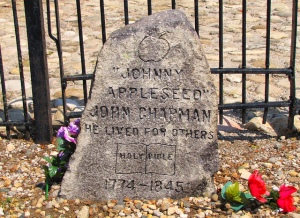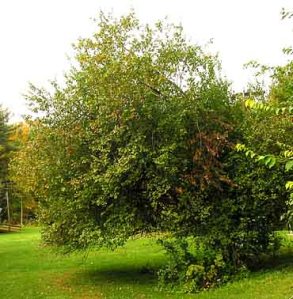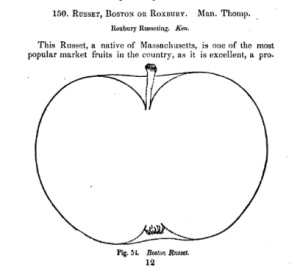In the Disney version of the Johnny Appleseed story, Chapman is portrayed as a generic Christian missionary, who devoted his life to spreading the gospel to frontier families. In fact, John Chapman was a man of deep religious convictions, but he was an evangelist for a particular Christian sect called the Swedenborgians. If one were to offer up BCS-style rankings measuring the success of evangelizing Christian groups in the early 19th century, the Methodists and Baptists would be at the top, and the Swedenborgians would reside somewhere near the very bottom. Swedenborgianism was both intellectual and mystical, and it lacked the emotional, fire-and-brimstone fury which seemed to have great appeal in the early 19th century American west. Despite John Chapman’s best

Multiday religious camp meetings, where preachers appealed to listener’s emotions and fears, were a common form of evangelism in the early 19th century
efforts to get midwesterners to read the heady Swedenborgian tracts he freely distributed, interest in Swedenborgianism was largely limited to reading circles of urban intellectuals. What drew John Chapman, the frontier primitive, to this particular theology remains something of a mystery. I have my own ideas, which I explore in Chapter Four of Johnny Appleseed and the American Orchard. Below is an excerpt from the first part of that chapter, which offers a brief summary of the life and ideas of Emanuel Swedenborg.
In January 1817, John Chapman was holed up somewhere for the winter, perhaps boarding with Eben Rice and his family along the banks of the Black Fork, anticipating spring and another season of apple tree planting. At the same time the Reverend John
Clowes of St. John’s Church, Manchester, gathered with a small group of educated middle- and upper-class Mancunians for a regular meeting of group they had formed to promote the religious writings of a deceased Swedish physicist. They called themselves the Manchester Society for the Printing, Publishing, and Circulating of the Writings of Emanuel Swedenborg, a name that may have contained more words than the society contained members. Their task this day was to compile a report of developments that had occurred over the last year. Among the items they included in this annual report was a copy of a letter they had received from a member of a satellite community of Swedenborg enthusiasts in Philadelphia. The letter told a fantastical story:
There is in the western country [of the United States] a very extraordinary missionary of the New Jerusalem. A man has appeared who seems to be almost independent of corporal wants and sufferings. He goes barefooted, can sleep anywhere, in house or out of house, and live upon the coarsest and most scanty fare. He has actually thawed the ice with his bare feet. He procures what books he can of the New Church; travels into remote settlements, and lends them wherever he can find readers, and sometimes divides a book into two or three parts for more extensive distribution and usefulness. This man for years past has been in the employment of bringing into cultivation, in numberless places in the wilderness, small patches (two or three acres) of ground, and then sowing apple seeds and rearing nurseries. These become valuable as the settlements approximate, and the profits of the whole are intended for the purpose of enabling him to print all the writings of Emanuel Swedenborg, and distribute them through the western settlements of the United States.

Chapman delivering “Good news! Fresh from heaven!” to a frontier family. Illustration from Harper’ magazine, Nov. 1871.
The report from Philadelphia did not mention the “extraordinary missionary” by name, this strange primitive man who was busily extending the work of the Manchester society on the edge of Christian settlement in the New World. But the members of the society, who had up to this point found their efforts ignored— or worse, mocked— by most of England’s religious establishment, some of whom declared Swedenborg a madman, were certainly heartened to learn of this solitary American’s devotion to their common cause. It seemed to them that most men simply did not have the patience to read Swedenborg’s writings and penetrate the profound truths they contained. But at least one strange frontier primitive did. And if such a simple man, living on the remote edge of Christian settlement in the New World, could grasp the truths of the Swedish seer, then perhaps the day when all Christians would come to recognize them was not so far off, and a New Jerusalem on earth would be born.

A Swedenborgian tract of the sort distributed by Chapman. Often bound in volumes, Chapman unthreaded the so that he might share one volume with many families.
That John Chapman, son of a poor tenant farmer, would become devoted to the spiritual writings of a Swedish nobleman who died two years before his birth is something of a puzzle. The two men had little in common. Emanuel Swedenborg was a man of great intellect and learning; John Chapman had just a common school education during his Longmeadow boyhood. Swedenborg, the son of a bishop in the Swedish state church, was born into a privilege that permitted him to devote his life to study. The writings Swedenborg left behind at the end of his life fill small libraries; John Chapman’s copper-plate script only survives on a handful of IOUs and land deeds. Both men remained bachelors for their entire lives, a state perhaps brought on by their individual peculiarities and obsessions. As a man of great talent from a well-to-do family, Swedenborg certainly suffered no material obstacles to matrimony. But his most intimate relationships were with his journals. He devoted his early life to reading and writing on a range of topics including science, mathematics, engineering, and political philosophy. But in his fifties he began having dreams and visions that prompted a profound spiritual crisis. Visited by angels who told him that he had been chosen by God to advance a new understanding of the scriptures, Swedenborg abandoned his scientific studies and devoted his days to spiritual writings and scriptural exegesis. The angels also allowed him to travel to heaven and hell and revealed all the secrets of the afterlife to him. Swedenborg’s descriptions of heaven and hell were vivid and detailed, but he insisted that he alone had been granted this ability to converse with angels and visit the spirit world. He sternly warned others not to attempt such contact.
Swedenborg’s stories of his conversations with angels and his visits to heaven were not the first John Chapman had encountered. He surely heard the stories of the prophet

The early 19th century west experienced a revival of both white and Indian spiritualism. Tecumseh’s brother Tenskwatawa was an important native prophet.
Handsome Lake’s travels to the spirit world when he was living just a few miles away from his village of Burnt House in northwestern Pennsylvania. Those stories, in fact, had many similarities to Swedenborg’s. And the spiritual visions of Tenskwatawa and the story of how he predicted a solar eclipse were well known in the settlements along Owl Creek and the forks of the Mohican. Furthermore, the trans-Appalachian frontier in the first decades of the nineteenth century was crawling with would-be prophets. Some, like the Leatherwood God of Guernsey County, Ohio, claimed to be God in person. That John Chapman became drawn into Swedenborg’s heavenly visions made him neither particularly gullible nor insane, as some have suggested. He was in good company.
Swedenborg’s visions and conversations with angels led him toward a theology that upended many of the assumptions of the major Christian churches of his day. Among these were that the Second Coming had occurred in 1757, not in the physical world but in the spiritual one; that one’s spiritual fate was not sealed upon one’s death, but moral progress or decline could continue in the afterworld; that the dead could choose to dwell in heaven or hell, and some troubled persons might prefer the latter; and that others might be content to dwell in the lower levels of heaven forever, but some would seek to advance to higher places. Swedenborg also rejected an idea fundamental to the Lutheran Church— the state church of Sweden— that salvation was achieved by faith alone. Real faith was manifested in acts of charity and commitment to a life of usefulness.
While both the Catholic Church and the dominant Protestant ones promoted a God-centered heaven where physical needs and desires did not exist, and therefore marriage did not exist, Swedenborg presented a human-centered vision of heaven where the marriage bond continued. What Swedenborg called “conjugial love”— a perfect love between two persons who were true soul mates— existed in heaven, but people’s heavenly partners might not be the same as their earthly ones, especially if their earthly marriages had been less than ideal. Those who were celibate on earth, and for some reason chose to maintain that state in heaven, were segregated to a part of heaven where they might retain that “unnatural” state. But lifelong bachelors like himself, who desired an ideal “conjugial” relationship in the afterlife, would be partnered with a true soul mate in heaven.
Finally, Swedenborg’s “Doctrine of Correspondences” asserted that everything in the physical world had a spiritual analog, an insight that led him to declare that even the simplest, most direct passages of the Bible contained hidden meanings that had become
clouded and lost by Old Church leaders. He promised that his methodical biblical exegesis recovered these meanings, and once members of the Old Church had read and embraced them, a New Church— a Church of the New Jerusalem— would emerge on earth, bringing the Second Coming that had already occurred in the spirit world out into the physical one.
Swedenborg devoted the last twenty-eight years of his life to producing sixteen books outlining his visions of the afterlife, as well as several volumes of scriptural interpretation. He published his writings at his own expense. They were mostly ignored and sometimes ridiculed, but eventually the Swedish state church pursued heresy charges against some of his champions. Swedenborg never despaired. He knew that it might take some time for their truths to be absorbed and accepted. He seemed content to simply continue producing them, until his last days. Labeled a heretic in his home country, he spent his last years in Amsterdam and London, where he died in 1772.

























You must be logged in to post a comment.